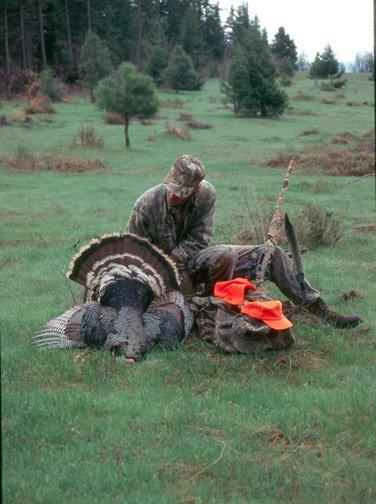Fooling Field Birds
A gobbler in a wide-open field may be the toughest bird you'll hunt all season. Here's how to get him.

You might as well find another bird, right, as this one's obviously unkillable? Or is he? It's true; you might never kill the field bird. However, you do have several tricks up your proverbial camouflaged sleeve that might … just maybe … convince him to make a mistake. The mistake; the one that earns him a ride in the back of, at least in my case, my late Grandpa Verity's old Chevy pick-up.
A SENSORY OVERLOAD
Decoys. The answer to this problem has to be decoys. But you've tried them. The lone hen, the tried-and-true jake and hen, and the Will he, or won't he? full-strut gobbler. Nothing, absolutely nothing, has made him move more than 10 or 12 puffed-up steps in your direction. So decoys aren't the answer, or are they?
A couple seasons ago, I found myself in just such a field bird predicament. This one was further complicated by the fact that not only was I unable to get permission to hunt this old bird's chosen area of operations, I couldn't hunt three of the four fields that bordered the one where he was stuck. And while I was given the go-ahead on the field adjoining his to the south, killing him would mean not only bringing him out of the field, but over a newly-strung four-inch-mesh hog panel fence. Oh, and did I mention I wasn't going to try to kill this bird myself? No, a good friend was going to try to take his first gobbler using a handmade recurve bow and homespun arrows. Nothing like making a difficult situation even tougher, eh?
The next morning, and knowing I had nowhere to adequately hide two gunmen, let alone someone toting a bow, Shawn, the archer, and I packed a pop-up blind and a pair of folding chairs into the corner of our field under cover of pre-dawn darkness. Over my shoulder a full-sized duck decoy bag held what I hoped was the answer to our problems with this particular bird. While Shawn readied the blind and our seats, I arranged my secret weapon: four collapsible hens, two full-bodied and fully flocked hens, a shorted-bearded jake, and last, but certainly not least, a full-strut gobbler with a toned-down head and authentic Eastern tailfan. I set the strutter 10 steps from Shawn's shooting window. The others were loosely scattered around him at distances ranging from five to 15 paces from the blind. As ready as we were going to be, we settled into the hide and poured our first cups of coffee.
Although day broke to hard gobbling, it was an hour or more before the bird, alone as he usually was, waddled into the field. Once there, he went directly to his usual small rise in the center of the parcel, and began his dance. I, as I'd done in the past, greeted him with a cacophony of cutts, cackles, and high-pitched yelps; however, this time, I threw in as part of my audio-visual illusion, some deep-throated gobbles, all with the volume set on HIGH.

Multiple decoy spreads for field gobblers can work, often because reluctant longbeards haven't been exposed to such a visual presentation. Coupled with extremely - and I mean extremely - aggressive hen talk mixed with jake yelps and full-throated gobbles, these duck spreads turned turkey rigs can flip that old boy's trigger and, as we witnessed firsthand, bring him literally on the run.
How many decoys? Here, I used eight total; however, I've used as few as five, and as many as 16, mixing collapsibles with full-bodies and, in some instances, throwing in eight or 10 silhouettes for added visual attraction, without adding greatly to the overall weight of the decoy bag I've now chosen to carry. Motion is key here, as your goal is the ultimate in realism. That said, at least half of my multi-decoy rig will be set on stakes which allow for some degree of wind-generated movement; not a full 360-degree Tilt 'a Whirl spin, but some side-to-side movement. And as for the gender and body posture of the fakes, I try to provide every psychological element, if possible - feeding hens to convey security and reproductive availability; alert or high-head hens for realism; passive jakes for competition; and the full-strut gobbler for territorialism. Sometimes it all works; sometimes, it doesn't. Still, when you've tried everything with a problematic gobbler, why not throw the kitchen sink at him? You really don't have anything to lose.
GO LOW PROFILE
There are times when a gobbler will shy away from a full-sized pop-up blind set dead center in the middle of a featureless pasture. Overly cautious birds call for desperate measures. Enter the goose hunter's layout blind.

A word of advice for those of you thinking, Man, this is going to be great! Prior to putting the layout blind into action, make the time to practice just a bit shooting from this rather unorthodox position. Take the blind to the range, set your patterning target at 25 steps, and practice aiming and firing effectively while reclined. You'll thank me later when you didn't have to learn the hard way how tricky pulling this seems easy shot off can actually be. I learned the hard way.
GET HIM AT THE BELL

What's that? Ambushing an old gobbler on his way to bed isn't a gentlemanly way of doing things? Well, sir, this longbeard hasn't played fair from Day One. And after all, I didn't ambush him. I merely leveled the playing field. Nothing wrong with that.






